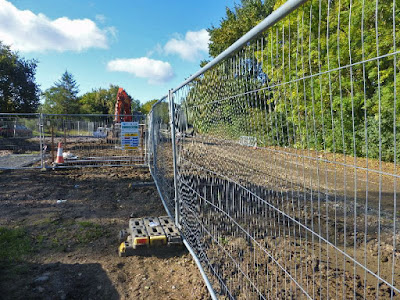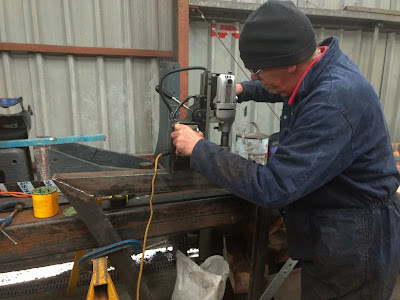Saturday at Toddington
Off to the unloading road! This was lifted on Wednesday, and today we came to remove the rails and concrete sleepers.
We started at the southern end, and you can see Nigel here in the Telehandler digging in to remove the sleepers 4 at a time.
Once a length of sleepers had been removed Stevie (behind the fence on the right) sprang into action with his JCB and extracted a pair of rails.
Dave was banksman, helping Nigel get the forks into just the right place, after which he could lift out the next load.
The concrete sleepers were stacked a bit further up. They need sorting out now - they are second hand second hands! Some are really too bad to bury forever in concrete.
While the JCB and Telehandler were doing the mechanical handling three of us checked out the loco yard for loose keys and fishplates.
Here you can see Nick and Pete tightening a fishplate, as seen from the platform of one of the new yard lamps. They have their uses....
No, it's not a drone view!
In the background is some of the parts from Dinmore Manor restorations - the cylinder for example looks like the cracked one from 3850, possibly the wheels and boiler are from the same loco, which is being worked on in the shed.
Also from the top of the outer yard lamp is this shot of the loco yard and shed.
Inside the shed was this view, mentioned by a comment on the previous blog. Are all these locos without boilers?
Yes they are! Count them: from R to L: 2807, 2874, 3850 and John. The two fascia boards are in there too, but not for much longer.

Trains ran on Saturday of course, two of them (weekend). This one was quite full as a mid day one, the beginning and end of day ones are less well patronised.
This is 4270 by the yard throat, just approaching the signal box for the token exchange.
At the end of the afternoon the unloading road between the loco and goods sheds had been completely lifted.
Our last shot of Saturday shows the stub end being corrected by Steve with his 'tweaker' - the small bucket, just pulling the rail towards him a little, as it had a kink on the end.
Bert Ferrule tells him how much.
The next stage is that a contractor will come and dig out the bed and level it for us. Once there is a nice level bed we can put the track back, straighter and more level than before as it will be capped with a concrete deck.
Swanbourne - a post scriptum
It is no more, it has gone to meet its makers, it is an ex-station.
Here it is as we knew it, with roof slates already removed. We hope to recover a pallet or two of these for the Usk hut, where we have some slates, but not enough.A few days ago, and the bulldozers had already been in.
No one lives here of course, so no station is needed
Today not only the stationmaster's house and the booking office have been cleared, but the two brick and stone platforms have been grubbed out too. Sadly we were not able to find anyone who could use the 100 or so 50cm natural stone blocks that were there. We tried several addresses, but no luck.
 Two shots of the interior (author unknown) showing a ropey counter and two former ticket hatches, one of which operative. We did have a taker for the ticket hatches, but after removal they vanished from the site, and he didn't get them after all. The panelling had woodworm.
Two shots of the interior (author unknown) showing a ropey counter and two former ticket hatches, one of which operative. We did have a taker for the ticket hatches, but after removal they vanished from the site, and he didn't get them after all. The panelling had woodworm.There was also this early Victorian fireplace, fate unknown.
Its round shape makes it early Victorian. Later ones were square, such as the one at Broadway, which is 1904.
Fireplace surrounds don't fetch that much on Ebay. The railway had a small one for sale but it attracted no bidders.
We are still negotiating for the recovery of building material from another station, but time is running out, the crusher is coming at the end of the month and we still don't have permission to enter the site. Not good.
Tuesday in the loco shed
Outside the shed on Tuesday, the contractor had returned to make a start on digging out the trackbed of the unloading road we lifted on Saturday. A lot of care was taken to get the level right, after which a roller compacted the soil. This area is all made up ground from 1905, plus years of tipping various stuff. The contractor got to the half way stage by the end of the day.
In side the shed it was a slow start for the canopy team, as a delivery of angle iron and rebar interrupted the fabrication, and it took quite a while to get all the bits stored in the dry.
John started welding pieces cut last Tuesday, but soon ran into issues involving the copper wire seizing up in the delivery tube.
The welding issues were eventually sorted out, after a lot of frustration. We didn't really make a good start until after lunch time, but then we forged ahead!
Here Neal is drilling holes into the angle supports where they will be attached to the uprights.
Having drilled several holes with the mag drill, Neal started laying out bracing strips that John was cutting on the saw.
We are doing these in pairs, as of the three supporting angles there is a double of each. They will be rivetted together in pairs, with a 10mm gap in between.
Here is one of the large supporting angles almost fully fabricated.
It may look like a small piece of work, but it contains not only a large number of pieces to cut, but also a large number of special angles. These angles produce the zig-zag pattern, and allow all the pieces to fit together seamlessly. They are then welded together. Later they are rivetted as well, to achieve the right look. The stubby welds holding them together for the moment will be hidden then.
Wednesday on the Usk platform.
Just two pictures today, but just as much progress. Yours truly was a bit off colour, better again tomorrow though. Dave kindly provided these pictures.
As Dave was one of the two laying bricks, there weren't many opportunities to take snaps, so you'll have to make do with these.
At the end of the afternoon, Paul is looking back over his work
40 blocks were laid today, bringing the total up to around 190 laid so far.
That pretty much covers the straight. We are just 12 blocks from the corner. Then things get a bit more complicated, as we'll be laying them from two sides at once.
We now have a small requirement where blog readers might be able to help - we need about a dozen 100mm concrete blocks. Currently the railway has no money for 'extras' like this, so we can't just go and buy any from our usual building supplies company. But sometimes such blocks lie about in people's gardens - do you have any to spare? If you have, get in touch with: breva2011 (at) hotmail.co.uk.
PWay gang at Winchcombe
The job today was to prepare for Saturday, when a start is likely to be made on relaying the unloading road at Toddington. As the materials there are very second-second hand, some will have to be improved before we bury them in concrete.
We need better concrete sleepers, as many of those at Toddington have loose chairs, or broken ends.
We have this pile, purchased for a relay job planned for the main line from the NYMR.
The Telehandler cleared the area in front of the sleeper pile, while Paul on the left is waiting on the WarFlat for the first load to arrive.
The wagon will then be taken to Toddington for unloading.
Might as well telephone the girl friend while you wait....
Others climbed on board to put down bearers for the journey.
As those on the WarFlat waited for the next load, Chris and Rob made themselves useful by scraping out the infill that had crept into the gaps between the crossing pads.
Jim was PIC and made sure that they lived to tell the tale. There was one train out today, said to be reasonably well filled and the new refreshment facility a5t CRC - no longer in a gazebo which blew away in a storm despite the 25Kg cast iron chair attached to it - was well used, we heard from a local source (Mrs. Blogger is reasonably reliable)
And that's it for today. Will we get the slates and the bricks from the platforms being demolished? Next week we will know.




























Great to see progress on so many fronts - any possibility of the Broadway footbridge timber work advancing on site, I thought that there was a small but positive opportunity if the the one set of stairs was completed to sell access tickets for photographers who wanted an alternative view from the bridge.
ReplyDeleteMalcolm
We need to get the steelwork completed first, we're on that case. We're probably on that for another couple of months. COVID changes make progress a bit unpredictable at the moment.
DeleteAfter the steelwork we'll be on the woodwork again.
Good progress on the unloading road.
ReplyDeleteAt least there are the photographs as a record and epitaph for Swancombe. Still a shame that it had to be demolished though. So much history is removed so quickly by the bulldozer.
I can't help but feel that after the fitting extension to the GWR goods shed, that the container storage sections with their aerial access don't quite fit in. Maybe for 1970's onwards but not for a steam heritage railway. O.K., critisism over. Everything else looks wonderful.
Regards, Paul.
I was wondering when someone would notice that!
DeletePragmatism, more pragmatism is what's needed keeps the world turning, everything can't be to everyone's liking every time.
ReplyDelete